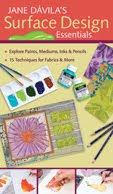I think I forgot to tell you that I was invited to join the Printed Fabric Bee earlier this fall. If you aren't familiar with this dynamic group, check out their (our!) blog for all the deets.
The first fabric I made was due the end of October and the theme was Science. Fun, but a little challenging until I decided to USE science instead of depicting science when making my fabric!
I decided to try a new product that I've only played with a few times before. It's called SolarFast from Jacquard and it is a water-based dye that reacts with UV light to "develop" based on what masks you place on the surface of your fabric.
The dye paints on in one color and the exposed areas develop into a different color.
I painted the first fabric with a combination of the pink and orange SolarFast dyes. For masks I used some of my smallest rubber gyotaku fish. The more opaque an object is, the more contract there will be from the masked to the unmasked areas.
I set the wet fabric in front of one of my studio windows and sat back to watch it.
Less than 5 minutes later you could definitely see some developing of color going on. Because the light was from a sharp angle, I noticed that the shadows the fish were casting was developing at a different rate than the uncovered fabric.
15 minutes total had passed by this point and the process was complete.
I removed the fish and decided that the contrast was a little TOO stark for me so I left it in the sun for another 3-4 minutes so the covered areas would have a chance to develop slightly.
After those few minutes I ran to the sink to rinse out the rest of the dye to stop the process as I quite liked how it looked at this point.
The completed, rinsed and pressed fabric! That was a blast - I definitely need to play with this more. The fabric is just as soft as it was before I started the project. It took about 30 minutes from beginning (opening the bottles and cutting a square of fabric) to end (the final press and squaring up).
Here is a collage of images from the other Printed Fabric Bee members and whaT their Science fabrics look like.
Have you tried Jacquard's SolarFast yet? What do you think?

















